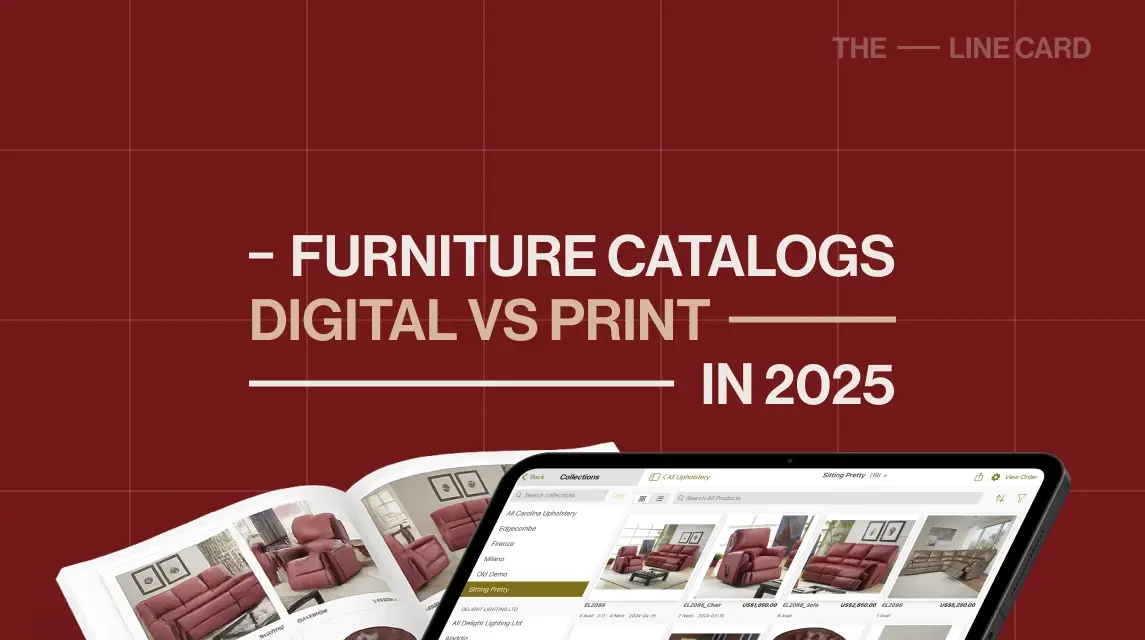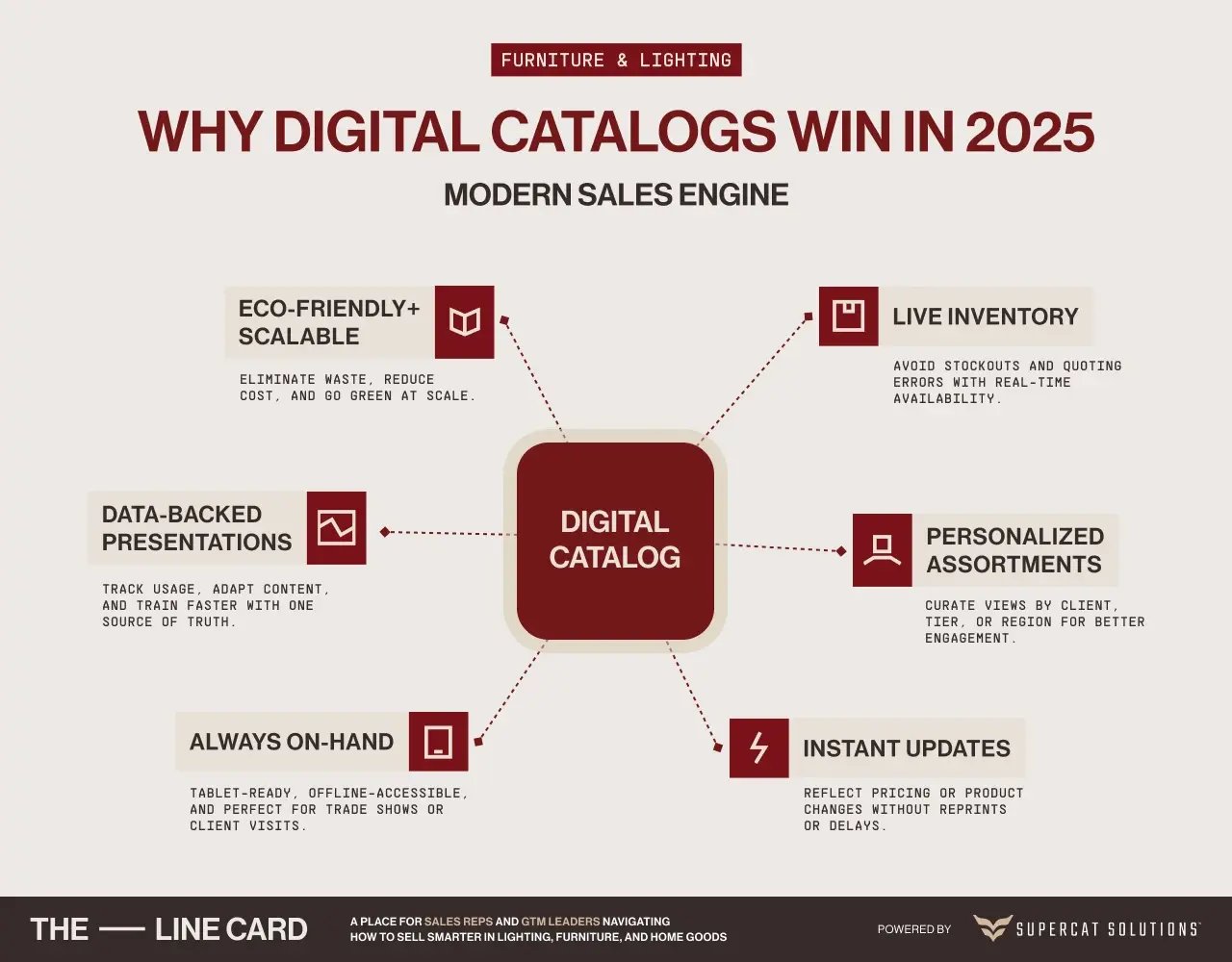
For years, print catalogs were the gold standard in furniture sales. Brands mailed out thick, glossy books filled with product photography and spec sheets. They were a key tool at trade shows, showrooms, and in-person buyer meetings. Buyers flipped through pages, circled SKUs, took notes, and passed them around teams.
But as product lines expanded and customization became the norm, print started falling behind. New finishes? Updated pricing? Inventory changes? Print couldn’t keep up.
Today, in 2025, interaction looks different. Sales reps carry tablets instead of binders. Buyers tap, zoom, filter, and build quotes on the spot. Catalogs have evolved from static documents into dynamic selling tools, and the difference shows in speed, accuracy, and buyer experience.
As the industry adapts to faster sales cycles and evolving buyer expectations, one question remains: Is print still worth the effort, or have digital catalogs taken over? To answer that, let’s explore why catalogs still matter and what’s changed.

Why Catalogs Still Matter
Even as formats evolve, catalogs remain foundational tools in furniture and lighting sales. This industry depends on more than specs. It requires visual context, design storytelling, and reliable product information. Whether digital or printed, a well-crafted catalog plays several essential roles throughout the sales process.
Product Presentation
Catalogs offer a visually engaging way to showcase product lines, materials, finishes, and collections. In furniture and lighting, where design is central, visuals do the heavy lifting. Buyers need to see how a velvet sofa looks in multiple colorways, how a pendant light interacts with space, or how a dining table sits within a fully styled interior. This visual clarity speeds up product understanding and purchasing decisions.
Centralized Information
A catalog serves as a single, organized source of truth for product data. It includes SKUs, dimensions, finish options, pricing tiers, lead times, and availability.
In an industry where products often come in multiple sizes and customizations, centralized access to this information helps prevent miscommunication. For example, a retailer evaluating a modular sectional can review layout options, fabric selections, and delivery timelines all in one place without switching between tools or awaiting rep follow-up.
Sales Support Tool
Sales reps use catalogs to guide conversations during showroom visits, buyer meetings, and trade shows. Whether flipping through printed pages or navigating a tablet, a clear catalog helps them present assortments, explain options, and answer questions efficiently. It enhances professionalism and makes every pitch more structured and persuasive.
Brand Communication
A catalog expresses your brand’s identity and design values. This applies whether the focus is luxury minimalism or handcrafted tradition. Typography, photography, layout, and tone all contribute to how a brand is perceived.
A well-executed catalog becomes an extension of the showroom. It builds an emotional connection with buyers at first glance. It also ensures brand consistency across sales teams and markets, so partners and reps tell the same story with the same voice.
The Limitations of Print Catalogs
Print catalogs have long been a staple in the furniture and lighting industry, but today’s market demands speed, flexibility, and accuracy. Here are the main reasons why many brands are moving away from print.
Information Becomes Outdated Quickly
Once a catalog is printed, there’s no way to update it. Pricing changes, discontinued SKUs, and inventory updates are impossible to reflect, which leads to confusion, miscommunication, and outdated presentations.
High Costs
Design, photography, printing, and shipping come with a high price tag. For brands with large catalogs or frequent product launches, the cost of keeping materials current adds up fast, and every revision means starting over.
For instance, printing a standard 8.5" x 11" saddle-stitched booklet with 16 pages can cost approximately $0.41 per unit when ordering in bulk quantities, according to PrintSafari. However, smaller print runs or catalogs with premium finishes can significantly increase the per-unit cost. For example, Fotorecord notes that a single 8-page catalog printed on satin finish paper can cost up between $26 and $0.50 per booklet.
Additionally, Gobook Printing highlights that printing 250 copies of a 6" x 9" may cost around $2 per piece, with prices decreasing as the quantity increases.
These figures do not account for ancillary costs such as design services, high-resolution photography, or distribution expenses, which can further escalate the total investment required for printed booklets.
Limited Customization
Everyone receives the same catalog, regardless of account type, location, or buying behavior. This lack of personalization makes it harder for sales reps to focus on what matters to individual buyers and often requires supplemental materials.
No Real-Time Inventory Visibility
A printed page can’t show live availability. Sales reps must rely on separate systems or manual checks to confirm what’s in stock, slowing down the quoting process and risking overselling or missed opportunities.
Hard to Scale or Localize
Adapting catalogs for different languages, currencies, or regions takes time and adds complexity. With each new version, the risk of inconsistencies increases, especially across international sales teams and distributors.
What Digital Catalogs Offer
Digital booklets have transformed the way sales teams, retailers, and buyers interact with product information. Unlike print, they provide flexibility, speed, and personalization.
Real-Time Updates
Digital tools allow instant updates to product availability, pricing, and assortments. When a finish is discontinued or inventory levels shift, the information is reflected immediately, with no need to reprint materials or resend outdated files.
Interactive Visual Experience
Zoom into product textures, rotate 3D models, or view lifestyle photography in full-screen. Digital catalogs can include videos, hover effects, and animated transitions, giving buyers a more immersive feel than any printed page.
Personalized Assortments
Sales reps can create custom views of the catalog tailored to each client’s market, style preferences, or account tier. This makes every presentation more relevant and increases buyer engagement.
Integrated Ordering and Quoting
Instead of flipping through pages and writing down SKUs, buyers can click to build quotes, request samples, or place orders. Digital catalogs often sync with order management tools to streamline the process.
Lightweight and Accessible
There’s no need to carry heavy binders or wait for shipping. Reps can access the full catalog from a tablet or phone at trade shows, showrooms, or during client visits with or without Wi-Fi.
Environmentally Friendly
Digital formats reduce paper use, ink waste, and emissions tied to printing and logistics. For brands committed to sustainability, switching to digital aligns with broader ESG goals.
How Sales Teams Use Digital Catalogs
Used daily by reps, managers, and partners, these interactive tools make it easier to present products, build quotes, and close deals more efficiently throughout the entire buyer journey.
During Client Meetings and Showroom Visits
Sales reps open them on a tablet to walk through product assortments, show finish options, and check stock levels on the spot. This replaces printed binders and makes the interaction feel modern and polished.
At Trade Shows and Design Fairs
Instead of shipping hundreds of catalogs, teams bring one device that can showcase the entire product line, generate interest lists, and send digital tear sheets immediately. It’s lighter, faster, and easier to update.
On the Road or in the Field
Territory managers and independent reps rely on digital catalogs while traveling between retailers, designers, or regional distributors. With offline access, they can present, quote, or take orders even without a Wi-Fi connection.
In Remote or Virtual Sales Calls
Sales teams use screen-sharing during Zoom or Teams meetings to walk buyers through curated collections or new launches. Clickable layouts, videos, and spec sheets make remote conversations more engaging.
For Custom Presentations
Digital catalogs let reps build client-specific assortments, export branded PDFs, and send tailored emails with just the relevant products. This makes every touchpoint more personal and efficient.
By Sales Operations and Enablement Teams
Sales leaders use the catalog as a central content hub. They track usage, update product content, ensure consistency across reps, and train new hires faster using the latest assets.

Are Digital Catalogs Better Than Print?
Each format offers unique advantages, but they serve different purposes in the modern sales process. While print catalogs still hold value in premium settings and tactile branding, digital catalogs give sales teams the agility, accuracy, and personalization they need to sell effectively across multiple channels.
The table below highlights how the two compare across key areas relevant to furniture and lighting brands:
| Feature | Digital | |
|---|---|---|
| Updates | Fixed once printed; costly to revise | Instantly updated across teams and regions |
| Cost Efficiency | High printing, design, and shipping costs | Lower long-term cost; reusable and scalable |
| Personalization | Same content for all buyers | Custom assortments and pricing per account |
| Interactivity | Static images and text | Videos, 3D views, clickable specs, PDF export |
| Inventory Accuracy | No real-time stock info | Integrated with live inventory and pricing |
| Portability | Bulky and hard to carry at scale | Accessible from tablets and phones anywhere |
| Sustainability | Requires paper, ink, and physical distribution | Eco-friendly; aligns with ESG goals |
| Buyer Experience | Traditional and tactile | Fast, modern, and responsive |
| Best Use Cases | Flagship showrooms, brand kits, premium mailers | Sales calls, trade shows, remote selling, follow-ups |
Modernize Your Catalog Experience
If your team is still navigating printed pages, outdated PDFs, or juggling spreadsheets, now might be the right time to explore something more dynamic. Digital catalogs offer faster updates, stronger buyer engagement, and greater flexibility for modern furniture and lighting sales teams.
SuperCat is a connected ecosystem designed to help you easily manage, present, and update your product catalog from the showroom to the sales call.
Frequently Asked Questions
Do furniture buyers still prefer printed catalogs in 2025?
Some premium buyers still enjoy the tactile experience of print, but most expect fast, flexible, and personalized digital tools.
Can a digital catalog fully replace printed versions at trade shows?
Yes, digital catalogs allow reps to showcase full assortments, check stock, and build quotes instantly, even offline.
How do digital catalogs improve the B2B sales process?
They speed up quoting, reduce errors, personalize assortments, and ensure real-time inventory and pricing accuracy across teams.
